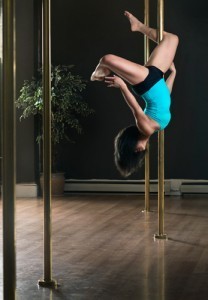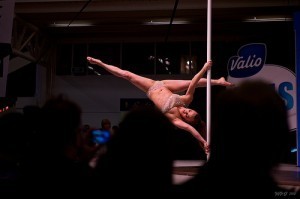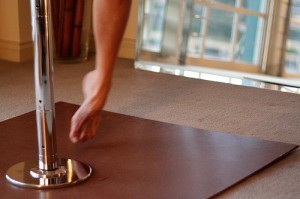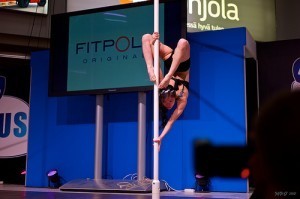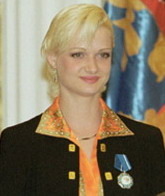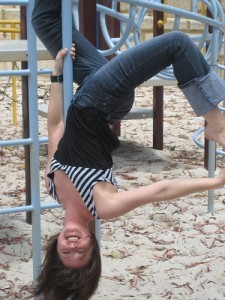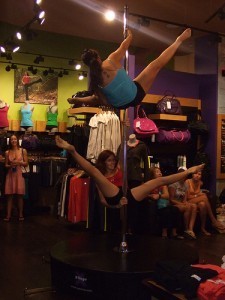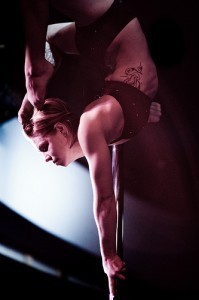10 power lessons about creativity from an unexpected source
“Dance first. Think later. It’s the natural order.” ― Samuel Beckett
I was at a dinner party in Beverly Hills when the hostess surprised us all with a visit from a poledancer.
The poledancer was not a stripper. She was a dancer and athlete who had recently won some kind of national poledancing championship. She spun her body around the pole like an acrobat, we applauded wildly, and she offered to teach us a move or two.
I eagerly volunteered, despite a back that was acting up. (You can see it in this video clip, which ends with a move I invented myself and like to call, Oh f*ck, my back.)
Then I started thinking about what poledancing can teach us about creativity.
I give you:
1. the power of reframing
A frame is the network of assumptions and expectations through which you view the world. It colors how you experience life (and how life experiences you). As Keith Sawyer points out in his book ZIG ZAG, a frame is like a mental shortcut, a quick way to answer the question What’s going on here?
We use it to assign meaning to a situation, figure out the intentions of the players, and predict outcomes and consequences.
One way to think differently – and more creatively – about a situation is to reinvent the way you view it.
Since a frame is about what you exclude as well as what you include, a reframe can open up new possibilities by showing you something that wasn’t there before, by incorporating new information or shifting your area of focus.
You can think of poledancing through a framework of strip clubs and prostitution, exploitation and degradation. Or you can reframe it as physical exercise that builds upper body strength and serious abs – not to mention is also a fun way to bond with your girlfriends.
Sheila Kelley reframes poledancing as a form of creative self-expression – and a feminist act. It’s a way for a woman to reclaim the sensuality that cultures the world over attempt to own, control and constrict. This is a powerful reframe (whether or not you agree with it) that not only flips poledancing from a symbol of degradation to one of liberation – but enabled Kelley to transform from actress to entrepreneur.
When you take a problem that has bamboozled you and find ways to reframe it, you find new ways to see, perceive and think about it. This could lead not just to a solution but a revolutionary new insight.
2. The power of being in your body
I have come to believe that sensuality and creativity are connected. Being in your body is about being alive to the moment: dropping out of whatever story you’re telling yourself in your head and experiencing the world through your senses, your feelings, yourself as a physical being.
You stop obsessing over the past or leaning into the future.
You are right here right now.
This allows the mind to calm the f*ck down, and the result is more than a sense of contentment and well-being. It involves the ability to see with fresh eyes and become more aware.
Professor Ellen Langer of Harvard studies what she calls mindfulness. It’s the ability to switch out of automatic pilot and into a state of active observation. Being “mindless” is an efficient way to get through the usual tasks and routines of day-to-day living. But it also traps us in predictability and sameness.
According to Langer, what sets artists apart from other people is their ability to step out of the frames and smash the mental categories through which other people process the world.
Artists have vision – and the ability to re/vision.
When you’re in your body, you can also listen to your body – those hunches, gut feelings, and flashes of nonverbal intelligence that deepen your understanding of where you are now and what your next move should be.
3. the power of mastering the moves
Creativity has a social context. Each field has its own set of experts with its own set of notions about what is traditional, conservative or cutting edge. In order to be creative in your particular field, it helps to have a level of domain knowledge: the deeper that knowledge goes, the more creative you have the potential to be. (Harvard psychologist Howard Gardner has proven that creative individuals tend to come up with major breakthroughs after ten years of deep involvement in their chosen field.)
In other words: I have very little ability to bust out some truly innovative poledancing moves because I don’t know what the hell I’m doing. I like to dance but I am not a trained dancer, acrobat or gymnast. (I am merely a book nerd.) I have no domain knowledge from which to draw ideas for a supercool poledancing routine.
As Cal Newport puts it: you have to master the rules before you can reinvent them.
4. the power of combining (and recombining) the moves
Creativity, as Steve Jobs so famously said, is about connecting things. It’s about taking different ideas and finding ways to take them apart and combine or recombine them (or elements of them).
In the case of poledancing, you learn the moves (domain knowledge) and then practice ways of putting them together that reflect your own personality. The more moves you master — the more your body absorbs the technique — the more and better raw material you’ll have through which to express yourself. Your style might be gymnastic, sensual or street – or something still waiting for you to invent.
5. the power of adding up little gains
Mastery doesn’t arrive all at once. You learn the moves one at a time. You have little personal breakthroughs, and days go by when you don’t feel like you’re breaking anything at all (except maybe your head against a brick wall).
It’s just part of the process.
When Keith Sawyer immersed himself in a study of creativity (resulting in the excellent book ZIG ZAG), he discovered that no matter what kind of creativity he studied, the process came out the same. Creativity did not light up the world – or the creator’s mind — in one single flash.
Or maybe it did – but as the accumulated result of years of effort.
Baby steps.
Fragments of insight.
Tiny changes.
You learn and study and ponder and practice and seek out criticism and adjust and grow and rinse and repeat. You can’t whisk yourself from Point A (total amateur) to Point Z (dazzling genius) without working your way through the letters in between. Creativity is not a teleportation device. It is, instead, a series of little gains — actions and insights – that link up into a chain that slowly but steadily lengthens across the creative gap: that vast sweep of distance between where you begin and where you want to end up.
As Gordon Gould describes his invention of the laser: “…I [suddenly] saw how to build a laser…But that flash of insight required the twenty years of work I had done in physics and optics to put all the ‘bricks’ of the invention in there.”
6. the power of refusing to compare yourself with others
This is so easy to say, I know, and difficult to do. Aside from the fact that comparing yourself to others will depress you and wither away your soul, it’s not practical. Someone who is 5’9’’ is going to put together a different routine and excel in different ways (and be limited in different ways) than someone who is 5’3’’.
Strengths and weaknesses are flip sides of the same coin. At 5’5’’, Svetlana Khorkina was almost unthinkably tall for an elite female gymnast.
She had to modify certain moves that the other, smaller gymnasts could do, such as doing multiple twists in the air instead of somersaults. Her height and her moves helped make her a standout, and she is regarded as one of the best gymnasts of all time.
Comparison, as Youngme Moon points out in her book DIFFERENT, is dangerous — because it means that everyone starts to compete along the same criteria. Sooner or later the differences level off and everyone starts to seem the same.
It’s better (and infinitely more interesting) to find the qualities unique to you — that set you apart — and develop them to advantage.
Hint: those qualities are linked to whatever people accused you of being too much of when you were growing up. For example: I was too scattered, absent-minded, and disorganized – the flipside to being unusually creative. I was also too intense, too serious, I used too many big words, and I thought too much (whatever that means).
My passion, my intellect and my ability to consume and synthesize information marked me ‘different’ as a kid, but serve me very well as an adult.
(I remember Kim Basinger saying in an interview how kids at school used to tease her for having such big lips. She would go home crying, and her father would tell her that one day her lips would be worth a million dollars. He wasn’t exactly wrong.)
7. the power of creating a safe environment
I’m not sure if anything inhibits creative expression like the fear of shame and judgment.
Fear keeps us locked into conservative thinking. In the face of thoughtless criticism, we shut down. We keep our thoughts and talents to ourselves.
Places like The S Factor stress a safe and supportive environment in which a woman can unleash her inner “erotic animal”. This frees her up to take risks, try new things, and learn and evolve.
Whenever you’re trying to create something, to innovate, to break through with new insights and ideas, take a look at your environment. Is it populated with people who are quick to shout you down or deflate you? (Are you quick to shout yourself down or deflate your own ideas before you even have a chance to get started? How do you talk to yourself, and would you talk to anyone else like that?)
Do you have a space where you can go, shut the door, and feel safe enough to play, let your mind roam, explore your ragged creative edge?
8. the power of playing
The thing about poledancing is that it’s fun. You can play around with the moves and find different ways to express yourself. You can take chances, experiment, and learn something new. When you hear the women in The S Factor’s advanced poledancing classes whooping and hollering, you know about all else they are having a great time.
Tim Brown has a great TED talk about “serious play”, in which he points out that play is only possible when you can relax and be light-hearted with the people around you. It’s why friendship, as Brown points out, “is a shortcut to play”.
When we’re trusting of our environment, we open ourselves up to new ways of exploring it.
Dan Goodwin defines superpowers as “the naturally occurring abilities we purposefully foster that amplify our human potential.” To succeed in a creative economy, we need to know how to
manipulate (deconstruct and hack), morph (think flexibly and be tolerant of change), and move (think “with [your] hands” and play productively…. [also] to see (observe and imagine), sense (have empathy and intrinsic motivation), and stretch (think abstractly and systemically).
We must “advance our abilities to collaborate and create.”
(Today, poledancing class: tomorrow, the world.)
9. the power of building in a feedback loop
You could get a DVD or download videos off the Internet and learn to poledance on your own, but isolation cuts you off from feedback – and limits your growth.
Mastery doesn’t require hours of practice — it requires hours of deliberate practice. Deliberate practice is when you’re working off your ragged edge, striving to achieve something that is just – beyond – your ability to grasp it – until suddenly it isn’t.
You’ve evolved.
Good, constructive, supportive feedback keeps you honest. It helps you correct and improve your technique as you go. It teaches you what is working, what you can build on – and what you should let go. Feedback keeps you tethered to the reality outside your own head. Delusions get shot down before they have a chance to thrive (many of us resist feedback for this very reason).
The fastest way to master anything is to be teachable: to seek out coaches and mentors and listen to what they have to say, even (or especially) when it means you have to check your ego at the door.
10. the power of being vulnerable
There’s no getting around it. To grow as a creative, you have to put yourself out there. It isn’t the surface, superficial stuff – the glib social persona – that truly moves people, that gets inside their soul and shakes up the way they see the world. If you want to resonate, if you want to make a difference, you have to show us something we’ve never seen before. You have to show us who you are.
(The great thing is — when you show who you are, you give other people permission to do the same. And they will.)
I love – the ironic, rolling-my-eyes kind of love – when people tell you to just be yourself. It seems like such simple, even simplistic advice – and yet if it was really that easy, would we have to keep advising and reminding each other to do it?
It’s one thing to know who you are (a challenge in itself). It’s another thing to master the tools and develop the skills that allow you to present yourself in a way that’s both honest and authentic to who you are – and relevant to other people (or else why should they even care?).
Being yourself involves an element of exposure: taking your inner life and opening it up to friends and strangers. When this is done in an authentic and relevant way, it connects with your audience’s inner life – and creates a sense of resonance. A sense not just of connection, but identification.
Great creative work not only shows us something new, it reminds us who we are — and that we’re not alone. Someone else “gets” us – which means they must be one of us. It connects us to the larger human community. It calls us home.






